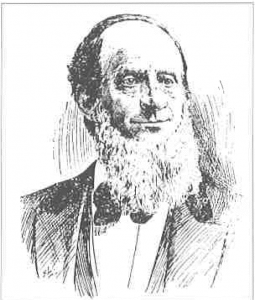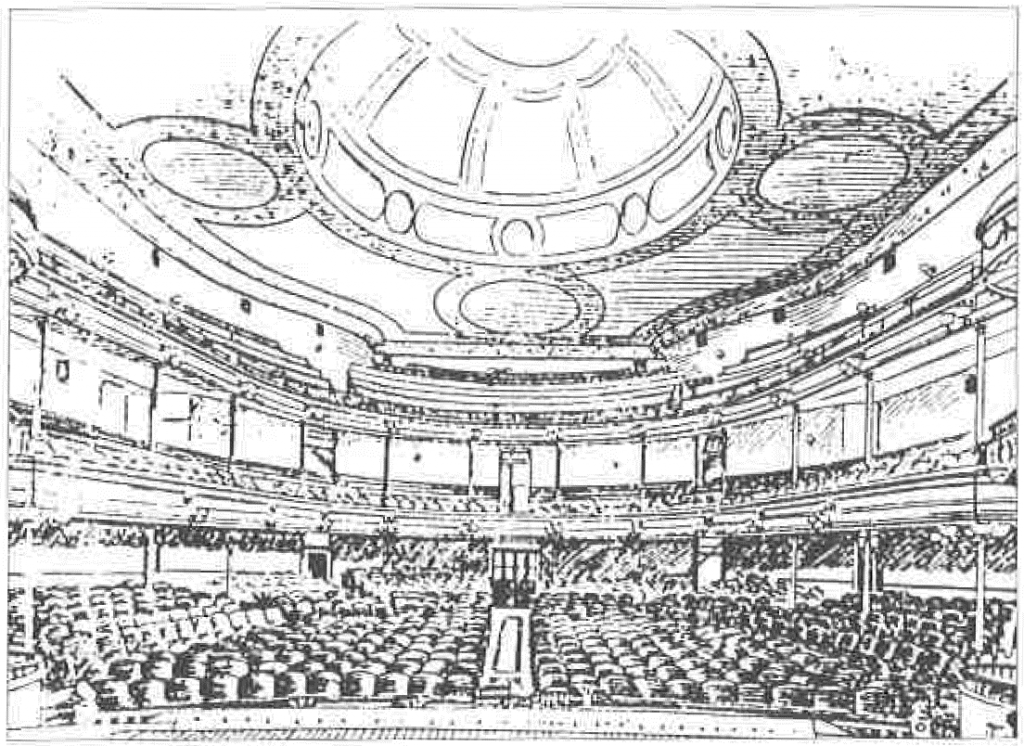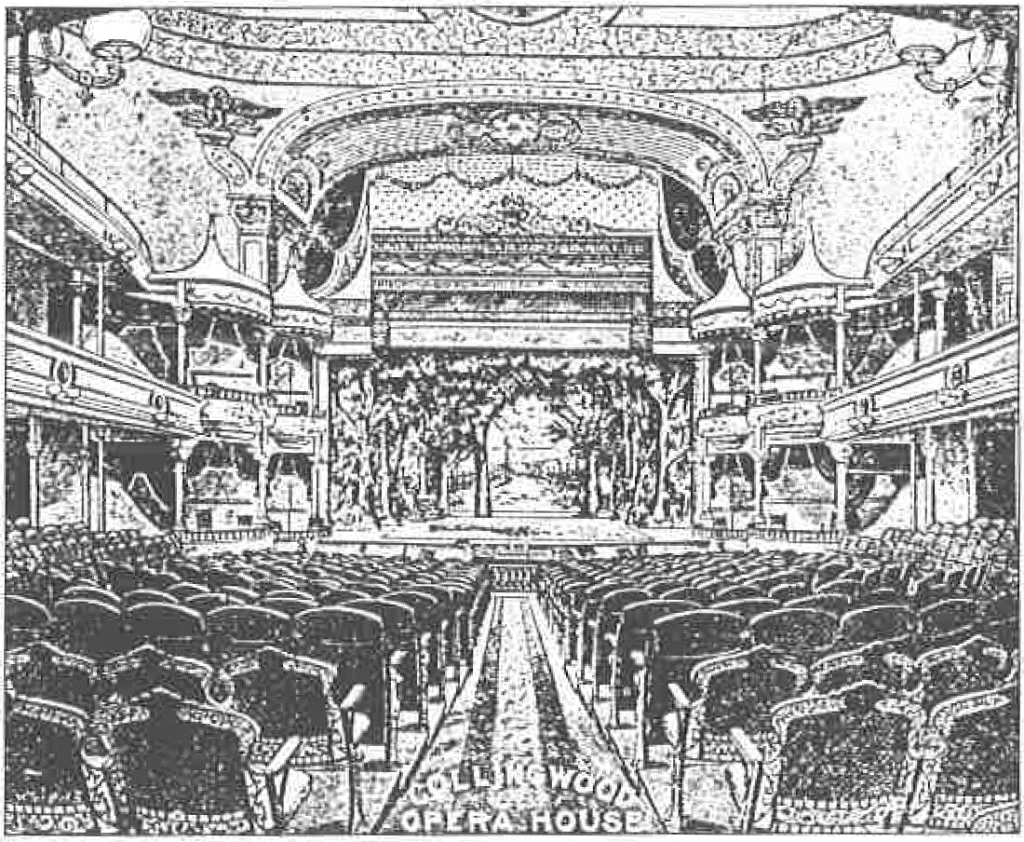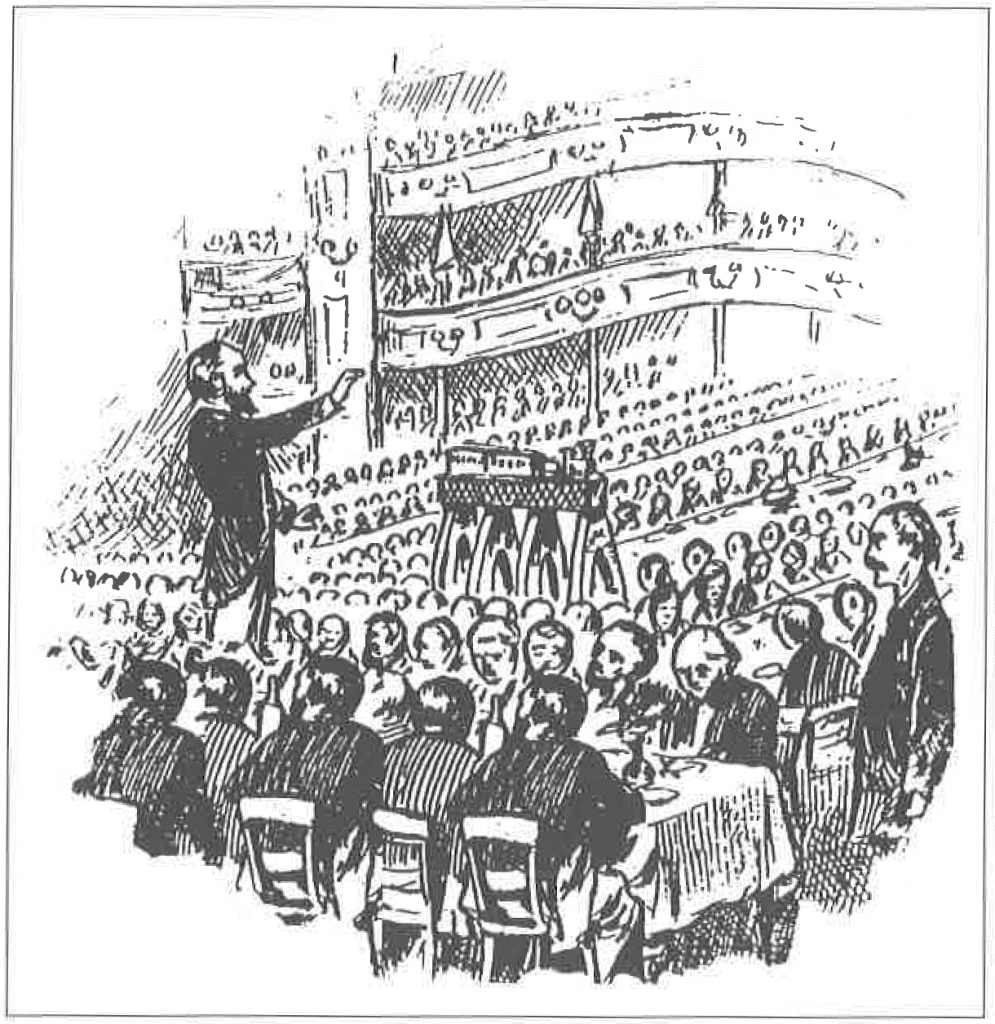19TH CENTURY OPERA HOUSES AND FLAT FLOOR EVENTS
By Annon Adams
Nineteenth century opera houses in small cities and towns were important to their communities not only for presenting plays, concerts, lectures, minstrel and variety shows, but also for hosting other community events.
The Collingwood Opera House, which opened in Poughkeepsie, New York on February 1, 1869, had a portable floor that was installed over the orchestra seats and was used for flat floor events during its first years of operation. The ability to provide a flat floor allowed the theater to host events that sealed its usefulness in the eyes of the community, bringing to the theater community members who were not otherwise likely to come.
This opera house was built to provide a larger, more dignified, and up-to-date theater for Poughkeepsie than its current theater, Pine Hall, which opened in 1860. Pine Hall was a second floor theater which had a flat floor with a raised stage and a single balcony like many school auditoriums have today. Local organizations used it for their charity fairs, festivals and balls.

James Collingwood, builder and owner of the Collingwood Opera House (Poughkeepsie Semi Weekly Eagle, Dec. 24, 1895)
After emigrating England, James Collingwood became a successful coal and lumber merchant, owning a coal and lumber yard on the from Hudson River’s shore. He also owned an office building at 35 Market Street, across from the courthouse in the center of Poughkeepsie. There was an opening in the office building to allow wagons’ passage to the uptown branch of his coal and lumber yard behind the office building.
In 1868 he tore down the buildings of the coal and lumber yard and began erecting a brick opera house in its stead behind the office building. The first floor opera house was entered through a broad hallway, the opening formerly used by coal wagons.
The opera house held 2,000 seats on three levels, 900 in the parquet and dress circle, 600 in the first gallery or family circle, and 500 in the top gallery. Balconies were horseshoe-shaped and the stage was flanked on either side by four boxes. The auditorium, shown below, was crowned with a two-stage dome which rose 75 feet from the main floor and was 40 feet in diameter. The stage was 60 feet by 34 feet, not including the dressing rooms, with a proscenium that was 36 feet high and 41 feet wide. (Fig. 3) Beneath the stage was a dining hall.
Though the Collingwood Opera House was larger and more grand than Pine Hall, it still needed to win the competition with Pine Hall to be a financial success and to achieve the preeminence in the community its promoters desired. Pine Hall’s builder had faced financial ruin when he failed to provide a proper stage, so as a sound business man, James Collingwood knew he needed to satisfy all of the community’s desires if his hall was to be a success.
One of Poughkeepsie’s fire companies – Phoenix Hose, the most socially prestigious one – wanted to be the first to inaugurate the new theater, and their event required a flat floor for dancing. Collingwood also wanted the approval of the conservative, religious women who composed the Board of Managers for the Home for the Friendless, as the local orphanage was called. He courted them to have their Fair and Festival at his new music hall, offering its use to them for free. The ability to provide the flat floor allowed the theater to host the events that had been using Pine Hall, sealing its usefulness in the eyes of the community and bringing to the theater community members who were not likely to come otherwise.

Collingwood Opera House, looking from stage to auditorium. Poughkeepsie Semi-Weekly Eagle, Dec. 24, 1895
Precise details on the installation of the floor are missing. The flat floor extended from the stage and covered the space ordinarily occupied by the orchestra or parquet of the floor are missing. The flat floor extended from the stage and covered the space usually occupied by the orchestra or parquet seats. A later recollection says that: “The Opera House had a false floor that when in place, extended from the footlights over the parquet and as far back westerly as to cover several rows of settees in the front of the first floor circle. The laying down and taking up of this dancing floor, which was in sections, required considerable labor and incidental expense.”
The auditorium of the Collingwood Opera House was horseshoe-shaped, so the flat floor covered the seats facing the stage in the center of the horseshoe. The remaining seats were available for spectators. Later, a screen or fender or skirt was added to encircle the floor, which the local newspaper reported was a great improvement. On January 19, 1872 the newspaper’s review of the Phoenix Hose Ball the night before said that “…the flooring was as smooth as glass.”
There were three types of events for which the Collingwood Opera House used the flat flooring: (1) fairs to raise money for charities; (2) balls as a social activity for fire companies or other groups and (3) community celebrations.
Some theaters were also used for sporting events. For example, a demonstration of the operation of the velocipede, or bicycle, was held at Pine Hall in 1869. The exhibition was open all day and free of charge. The paper reported, “Several hundred persons were present, and ten velocipedes were in operation.”
The first event at the Collingwood Opera House to use the flat floor was the Phoenix Hose Concert and Ball held February 3, 1869. There was a concert from 7:30-10 pm, followed by the Seventeenth Annual Soiree of Phoenix Hose. Smith Brothers Restaurant provided a supper in the dining hall of the opera house. “Hundreds of Ladies and Gentlemen listened to the sweet strains of the Band till nearly 10 pm, when the dancers appeared on the scene, and from that time forth ’til early morning ‘tripped the happy hours away.” How the transition from concert to ball was managed has never been clearly stated. During the concert audience members occupied whatever seats were available. Perhaps, the band played on the flat floor and moved for the dancing. Seamless staging was not yet something patrons expected.

Collingwood Opera House, looking from rear of auditorium to the stage. From a program dated Sept. 27, 1900, Collection of Bardavon Opera House
The second flat floor event at the Opera House was the Fair and Festival for the Home for the Friendless, held afternoon and evening on February 5-6. The description of the tables at the fair also provides some description of the opera house’s stage. The children of the home had two tables against the back wall of the stage, one selling food and one selling items made by the children such as pin cushions and men’s slippers. In the dressing rooms along the side of the stage were booths selling crockery, kitchen utensils and other provisions. The Treasurer of the event sat directly under the drop curtain. “Ranged along under the edge of the Dress Circle are six long tables at either of which one can procure a substantial meal.” In the evening there was a fortune teller and also music by D. T. Morgan’s band. As the newspaper reported, “The scene at the Opera House last evening was a very enlivening one. The first gallery was filled with ladies and gentlemen, while the stage was uncomfortably crowded.”
The third flat floor event was the Germania Masquerade. It was a costume contest and masked dance presented by the local German cultural association. It appears to have been a new kind of event, and apparently was viewed as a social risk. The following rules were printed in the newspaper for the event:
ORDER OF THE OPERA HOUSE
- No smoking allowed.
- All masks are requested to assemble on stage behind the curtain and not go on the floor before the procession takes
- None but masks can join the first three
- Persons who do not take part in dancing, are not allowed to stand around the floor during dancing
- Persons occupying seats in the galleries should not stand up in front of
- In order to give every person a chance to see the performance on the stage, we would request all persons to clear the floor at the call of the first 4 – 5 dances.
First reports were that the Masquerade had been attended by more that 2,000 people who had greatly enjoyed themselves; however, the Poughkeepsie News Press also contained a Letter to the Editor from a local clergyman, which alleged “that certain persons of known disreputable character were admitted to the floor of the OPERA HOUSE at the Germania Masquerade.” Concluding: “It will only be by divorcing our public amusements from immorality that those who provide them can effect the countenance and patronage of virtuous people.” A later historian, and friend of the Collingwood family, wrote that among the maskers were “two brothers, scions of one of Poughkeepsie’s very blue-blooded families” and a young lawyer were each “accompanied by a person whose accredted vocation was unmentionable, and possessed an arrest record that would have prevented their entry to the Masquerade had it been known .”
At the time it jeopardized the future of the Opera House and seriously threatened Mr. Collingwood with financial loss. “My informant is authority that in less than ten minutes ‘the wireless of 1869’ had acquainted every spectator with the state of affairs… Never before nor since was there such a terrible local ‘tempest in a teapot,’ and had it not been for the disastrous effect for a time upon the Collingwood investment, the whole affair might justly be described as truly laughable.” The next year all masqueraders were required to remove their masks at the door to insure there was no repeat of this incident.
At the Turner Society Ball in January 31, 1870, the Cardiff Giant was advertised to be in attendance. The Cardiff Giant is a ten-and-a-half foot stone giant that was “discovered” in Cardiff, New York on October 16, 1869 and caused a furor. It was meant to be a petrified man, but after scientific investigation it turned out to be the “Great American Hoax.” People paid 50 cents to see the Cardiff Giant on exhibition. Such a good profit was made that P.T. Barnum even had a copy of the Cardiff Giant made to exhibit at his museum in New York City. Did the original Cardiff Giant or a copy of the original Cardiff Giant – a hoax of a hoax – appear at the Turner’s Ball? Reporting the next day the Poughkeepsie News Press said:
“Besides the ordinary numbers of masks, such as usually meet the eye of the spectator on such occasions flower girls, peasants, knights, devils, characters symbolic of the seasons, clowns, yankees, darkeys, etc. etc., there were several features that added much to the attractiveness of the affair. For instance – The Cardiff Giant, that perhaps calls for more notice than any of the rest, as it was viewed with special interest. It was brought on the stage by eight men, and after being placed upon the floor where all could view it, an interview took place which offered the audience no little amusement. The giant was very communicative and was quite humorous in his remarks. In explanation of his present petrified state he stated that he had served one term in the Board of Supervisors, and there had been ordered by the people to dry up. ”
In 1871, a new form of stage decoration was added for the balls. On the back stage wall, gas jets were arranged to spell out “Welcome” or the initials of the group giving the ball-a striking effect which the newspapers often commented upon.
June is the season for local strawberries, and church groups and others have strawberry festivals. On June 17, 1869, the Apokeepsing Lodge of Good Templars held a Promenade Concert and Strawberry Festival at the opera house. Next day’s newspaper review sets the scene at Collingwood the evening before. “Many splendid boquets (sic) were sold at reasonable prices, very many strawberries disappeared, gallons of soda water relieved hundreds of parched throats, and the one thousand three hundreds persons present enjoyed themselves by promenading, chatting, flirting, and in a dozen other ways. It was, indeed, the largest and finest assemblage of the kind witnessed at the Opera House this season.”
Many of these balls and fairs were repeated annually. New features would be added. Edmund P. Platt, a local retailer, recorded in his diary that his wife, Mary, “was dressed in highland costume and attended a shooting or archer gallery” at the Fair for the Home for the Friendless in February, 1871. In December, 1872 a Japanese Fair and Festival to aid the American Mission Home in Yokohama was held. A local young woman worked at this mission. Exotic Japanese goods were for sale. Planned for two days, the fair was so successful that the second day had to be canceled. Platt’s diary said: “This evening we went for supper to a Japanese Fair held in the Opera House today, we saw a number of fancy articles sent from Japan to be sold at the fair, also a nondescript animal or fish about a foot and a half long, has a head like a monkey and the body and tail of a fish.”
The flat floor was also used for two important community celebrations. The first was to celebrate the opening of the Poughkeepsie and Eastern Railroad which connected Poughkeepsie to Connecticut trains and thus all of New England. After an excursion on the newly completed Poughkeepsie and Eastern Railroad, there was a dinner at the Collingwood Opera House to celebrate. Principals of all the local railroads were invited to participate, while women and other guests had been invited to purchase tickets for seats in the galleries.
The flat floor was laid over the orchestra seats and tables had been set up to accommodate 504 persons. The basement dining hall held 200 more people. Those on the excursion were two hours late, and very hungry when they arrived. They “commenced an attack on the abundance of provisions before them.” Afterward there was a round of toasts for each railroad present and for the men who had built the Poughkeepsie and Eastern Railroad.

Mayor Eastman making a speech at banquet to celebrate laying of Poughkeepsie Railroad Bridge cornerstone held on Dec. 17, 1873. Unknown newspaper source
The celebration of the laying of the cornerstone for the Poughkeepsie Railroad Bridge was a much grander affair. Guests included Andrew Carnegie and the President of the Pennsylvania Railroad, J. Edgar Thompson. The rendering below depicts the Mayor of Poughkeepsie raising his had in a toast to the seated guests on stage and mostly women in the galleries. In front of him is the cake made in the approximate form of the railroad bridge. The menus for the multi-course banquet were printed on satin. The decorations were described thus:
From each pillar supporting the galleries hung small flags, alternating in color white and blue. From the cupola in the roof hung full-sized American flags as radii from the center, and streamers ran to each angle of the house… At the rear of the stage, the curtain being raised was a large map 20 feet square, showing all the Railroad connections with the bridge. The main feature of the dinner and the one which attracted the most attention, was a confectionery model of the bridge. The piers, rising from the blue service (sic) of the river, sustained a track on a trestle work. Under the track was a roadway with carriages, and on the top a railway train. The whole construction was very ingenious, and reflected great credit upon its designer. Never had the Opera House presented such a fine appearance.
The celebration took place on December 17, 1873, a couple of months after the Panic of September, 1873. The railroad bridge project had many more hurdles to overcome before it finally opened in 1888. This celebration was one of the last events held using the flat floor at the Opera House. An armory was soon to open where community events could be held. The mania for balls and masquerades was wearing off as problems with the behavior of guests continued. New types of fund raisers were held for local charities which used the Opera House’s stage. The floor was time consuming to set up and take down, and its use was abandoned in the mid-1870s.
The need for flat floors continues today. The Paramount Theatre in Seattle installed seats on the first floor of the auditorium which can be mechanically moved to provide a flat floor for dinners and other events. The Keck Theatre at Occidental College in Los Angeles has seats that open like a clam shell that can be moved back as gym bleachers do to create a flat floor for dinners. Today, restored theaters serve their communities in multiple ways just as did nineteenth century opera houses.
If you find this story fascinating, we have a treasure trove of information about the history of your favorite theatres. Sign up for an account on historictheatres.org and enter through the STAGE DOOR!
For nearly fifty years Theatre Historical Society of America has been celebrating, documenting, and promoting the architectural, cultural, and social relevance of America’s historic theaters. However, we can’t do it alone. Support from cinema lovers, architects, historians and people like you are paramount to our success. Become a member today, and help us preserve the rich history of America’s greatest theatres.


 Next Post
Next Post